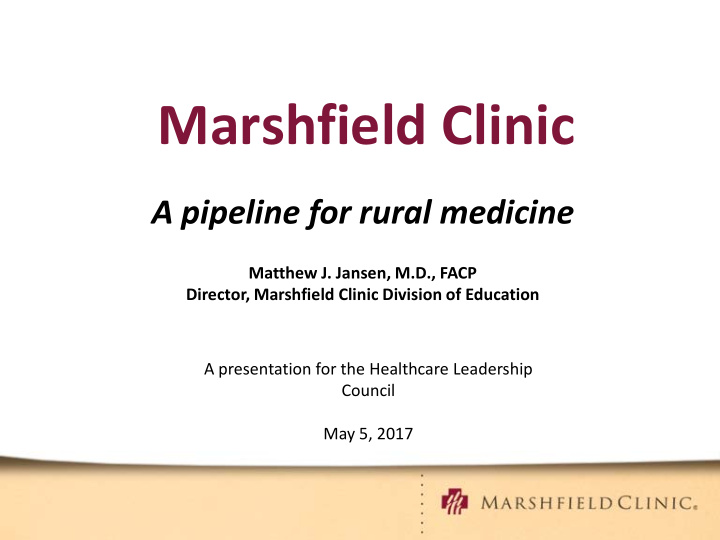



Marshfield Clinic A pipeline for rural medicine Matthew J. Jansen, M.D., FACP Director, Marshfield Clinic Division of Education A presentation for the Healthcare Leadership Council May 5, 2017
MISSION (WHY WE ARE HERE) WE ENRICH LIVES to create healthy communities through accessible, affordable, compassionate health care. VISION (WHAT WE ASPIRE TO BE) WE WILL INNOVATE AND DEFINE THE FUTURE OF HEALTH CARE FOR GENERATIONS. We will be the consumer’s first choice for health care. CORE VALUES (HOW WE TREAT PATIENTS, COMMUNITIES AND ONE ANOTHER) PATIENT-CENTERED: We listen, serve and put the needs of the patient first. TRUST: We earn trust through honesty, integrity, respect and compassion. TEAMWORK: We work together, respecting each other and our professional roles. EXCELLENCE: Through research, education and best practice, we deliver exceptional quality. AFFORDABILITY: We are accountable as we manage resources and deliver value-based care.
Primary Service Areas – 28 Counties
Marshfield Clinic in 1916 Medical Library 1916
Marshfield Clinic Health System Today 663 physicians and 400 non-physician providers More than 80 medical specialties Nearly 7,000 plus staff (and growing) 1.4 million patient encounters at main Marshfield Center campus during past year Patients from every Wisconsin county, every state in the U.S. and nearly 30 foreign nations.
Marshfield Clinic Health System Marshfield Clinic Division of Education Marshfield Clinic Research Institute Security Health Plan Marshfield Labs Applied Sciences Marshfield Food Safety Marshfield Clinic Information Systems
Marshfield Clinic Health System Marshfield Clinic -- Clinical Care Over 50 Regional Centers Family Health Center Diagnostic & Treatment Center Flambeau Hospital Lakeview Medical Center 10 Dental Clinics and more on the way Eau Claire Hospital under construction Marshfield Hospital transition Hospital at Home
State-of-the-Art Facilities Ambulatory Surgery Center Surgical Robot Patient Simulation Lab Imaging Center Telemedicine Multiple Labs Hyperbaric Center (coming soon) And much more…
Education Milestones 1927 Educational partnership with UW Medical School that brought students to Marshfield Clinic for first-hand experience 1969 Affiliated/accredited residency and student training program launched at Marshfield Clinic/Saint Joseph’s Hospital 2008 Wisconsin Academy for Rural Medicine (WARM) Program inaugural site
Residency & Fellowship Programs Dermatology: 6 residents More than 80 of our Internal Medicine-Pediatrics: 8 residents graduates are General Surgery: 15 residents caring for patients Internal Medicine: 27 residents throughout the Marshfield Pediatrics: 18 residents Clinic System. Pharmacy: 5 residents Many Practice Palliative Medicine Fellowship: 1 fellow in Wisconsin Post-Doctoral Psychology Fellowship: 4 fellows 711 residents and 41 post-doc graduates over past 40 years
Student Programs Total Learners Processed Within Student Programs Visiting Residents Medical Students Medical Assistants, Surgical Technicians, Other Technicians High School Students (Career Days) Nursing Students Marshfield Lab Learners Pharmacy Students, Radiography Students, Dietitians, Other 810 Total Learners / 1,599 Learner Rotations Scheduled / 62 Academic Contracts
Wisconsin Academy for Rural Medicine Marshfield Clinic first host site for WARM in 2008 Rural pipeline created to address physician shortage in diverse Wisconsin communities More than 33 percent of Wisconsin citizens live in rural areas but only 11 percent of 45 graduates from WARM Program physicians have rural practices as of May 2017 83 percent of Wisconsin counties are designated totally/partially medically underserved
Extension of Marshfield Pipeline Growing pharmacy residency program with hospital-track Partnership with University of Wisconsin-La Crosse PA School Partnership with University of Wisconsin-Eau Claire School of Nursing 16 nursing students in each class 80 total nursing students in program Addition of School of Radiography Addition of School of Nuclear Medicine
Overcoming Barriers… Graduate Medical Education: Increase of number of slots (primary care areas such as Internal Medicine, Pediatrics, Family Medicine and Behavioral Health) Removal of rural hospital resident allotment (“cap”) Teaching Health Centers (THCs) Mega THCs Nursing education funding Other rural health care providers Physician assistants, pharmacists, dietitians, etc.
Recommend
More recommend